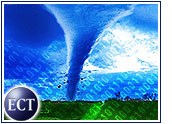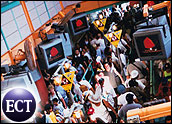
With Hurricanes Charley and Frances inflicting an estimated $40 billion worth of damage to the state of Florida in just three weeks, insurance companies have been forced onto high alert.
“Natural disasters are our business,” Jeanne Salvatore, spokeswoman for the Insurance Information Institute, told CRM Buyer.
Companies have answered questions from property and casualty policyholders, visited devastated areas and created on-site war rooms with catastrophe experts and claims representatives.
Managing Disaster
Insurance companies maintain relations with catastrophe experts even in relatively quiet times. As storms begin to build, they set up toll-free numbers specific to the impending disasters. Before the winds overtake homes, cars, churches and businesses, hotline representatives answer questions about coverage and claims processes. Many companies offer customer service through the Web, too.
For instance, wind damage from hurricanes typically is covered under standard homeowner’s, condo and rental insurance policies. Losses from flooding, however, generally are not covered by these policies.
Insurers and industry groups alert affected citizens to available services.
“The insurance industry takes great pains to assist customers in disasters,” said Salvatore.
Information Centers
War rooms emerge immediately when a storm is forecast, bringing together weather experts and human assistance agencies with claims groups, local government representatives, media spokespeople, health care services and county and municipal evacuation plans.
“It’s a military operation,” Salvatore said.
Insurance firms boost the staffs of call centers, both through in-house additions and outsourcing. In late August, in the wake of Hurricane Charley, companies also created the industry-wide Hurricane Insurance Information Center in Punta Gorda, Florida.
The HIIC offers claim-filing tips and maintains an active consumer outreach program. The center served as the primary resource of insurance information to the media.
The insurance industry has created similar disaster information centers following other major property and casualty upheavals, including Hurricane Andrew in 1992, the Northridge earthquake in 1994 and the terrorist attacks of Sept. 11, 2001.
Andrew’s Lessons
“This is a little bit of a unique situation with Hurricane Charley having just passed through,” George Nolan told CRM Buyer. Nolan, a spokesperson for Allstate’s National Catastrophe Team, is working with Allstate mobile response units in Florida. The units cater to Allstate customers who lack telephone and electrical service but want to get their claims filed early.
Allstate had 600 adjustors in place in Florida after Hurricane Charley, and 600 more joined that team once Hurricane Frances cleared.
Allstate’s message emphasizes safety. That’s been particularly necessary with Hurricane Frances, Nolan said. “The storm came through slowly and people were itchy to get back into their homes, perhaps too soon,” he said.
Twelve years ago Hurricane Andrew — previously the most costly storm to hit the United States — tossed the lives and property of people in Florida, Louisiana and Mississippi into tumult, inflicting damage worth $15.5 billion ($20.4 billion in today’s economy).
Such past natural disasters have given the insurance industry real-time experience with which to improve the claims process.
That will be crucial, given that damage from the two more recent storms will be even worse than Andrew’s.
Software Solution?
To manage the risks of major storms, some insurers are turning to the software of Eqecat, based in Oakland, Calif.
According to Eqecat senior vice president Tom Larsen, many insurers went out of business following Hurricane Andrew, and virtually all were adversely affected.
As a result, some purchased software from Eqecat to help them model risk and decide how to distribute it — by purchasing reinsurance, for instance. Essentially, reinsurance is insurance for insurers, allowing them to spread some of their risk to other companies.
In addition, when customers in risk-prone areas make home improvements — such as new storm shutters or better glass in their windows — and want credit for these safeguards, Eqecat software helps insurers decide the value of these improvements and what credit to apply to policy premiums.
“Planning for a natural disaster starts more at the top level,” Larsen told CRM Buyer. “Insurance companies have a lot of risks on their books. They have to know that if a natural disaster occurs, they can handle it.”











































